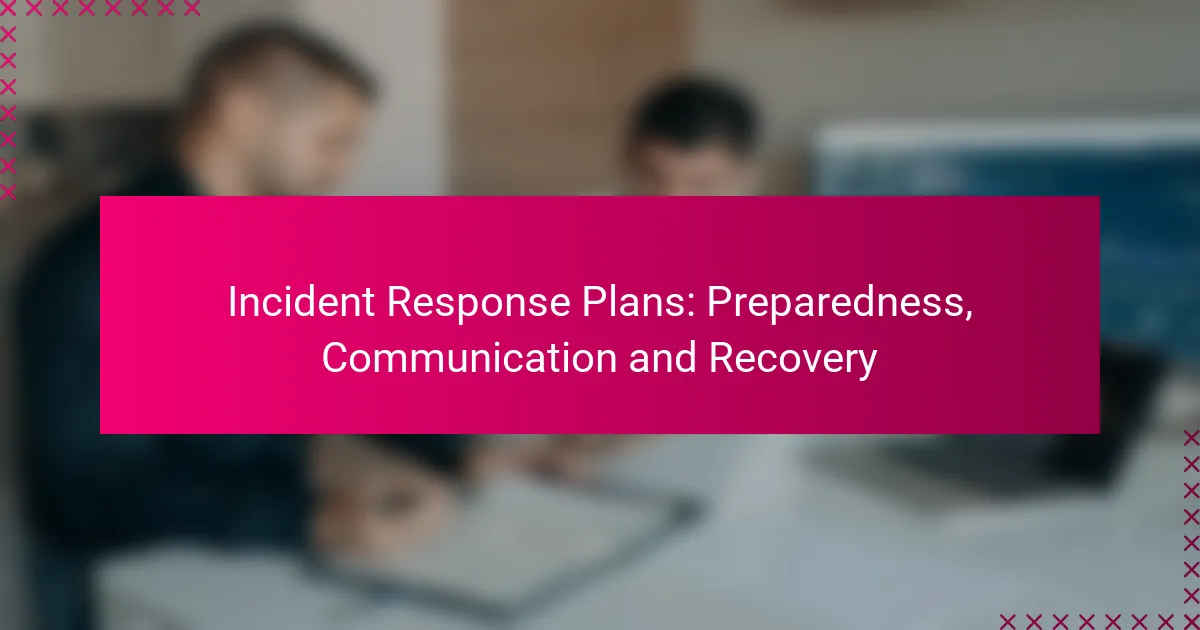An incident response plan (IRP) is vital for organizations to effectively manage security incidents and minimize potential damage. It encompasses key components such as preparation, communication, and recovery strategies, ensuring that all stakeholders are informed and coordinated during a crisis. By establishing a structured approach and conducting regular training, organizations can enhance their readiness and response capabilities.

What are the key components of an incident response plan?
An incident response plan (IRP) is essential for effectively managing security incidents. Key components include preparation, detection, containment, eradication, recovery, and post-incident review, each playing a critical role in minimizing damage and ensuring a swift recovery.
Preparation and planning
Preparation involves establishing a clear framework for responding to incidents, including defining roles and responsibilities. Organizations should conduct risk assessments to identify potential threats and develop tailored response strategies.
Regular training and simulations are vital to ensure that all team members understand their roles during an incident. This proactive approach helps to identify gaps in the plan and reinforces the importance of readiness.
Detection and analysis
Detection focuses on identifying incidents as they occur, using monitoring tools and threat intelligence. Organizations should implement automated systems to alert teams to suspicious activities or anomalies in real-time.
Once an incident is detected, thorough analysis is crucial. This involves gathering data to understand the nature and scope of the incident, which aids in determining the appropriate response actions.
Containment and eradication
Containment aims to limit the impact of an incident by isolating affected systems or networks. Quick actions, such as disabling compromised accounts or blocking malicious traffic, can prevent further damage.
After containment, eradication involves removing the root cause of the incident. This may include applying patches, deleting malware, or addressing vulnerabilities to prevent recurrence.
Recovery and post-incident review
Recovery focuses on restoring systems and services to normal operations. This process should include validating that systems are secure and functioning correctly before bringing them back online.
A post-incident review is essential for learning from the incident. Teams should analyze what worked, what didn’t, and update the incident response plan accordingly to improve future responses and strengthen overall security posture.
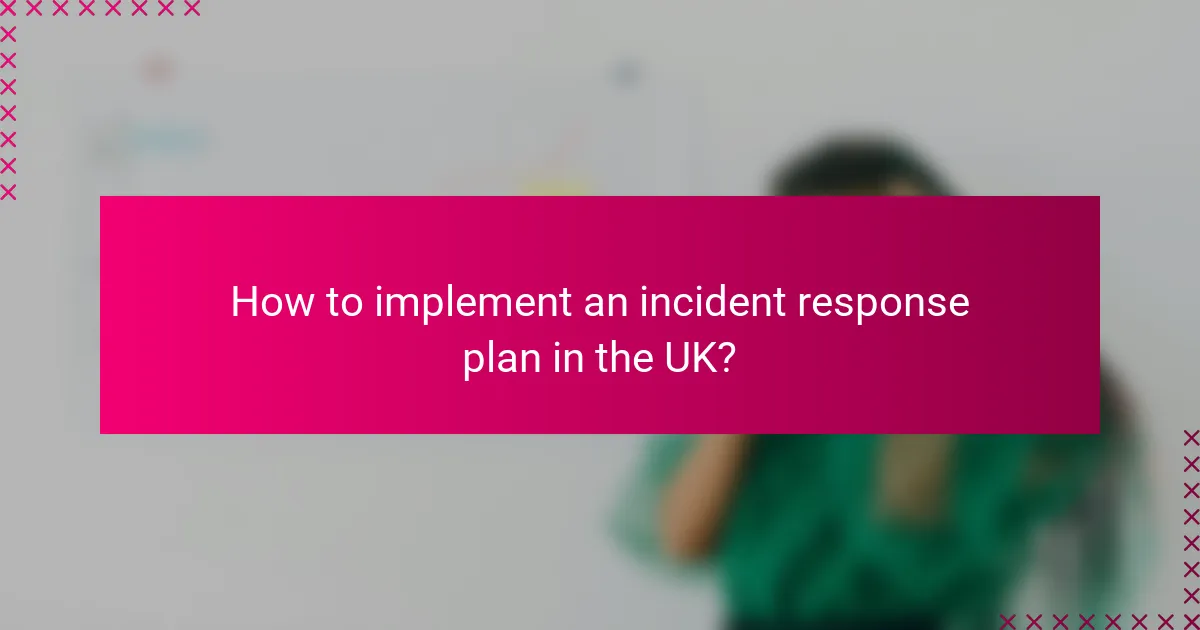
How to implement an incident response plan in the UK?
To implement an incident response plan in the UK, organizations should focus on establishing a structured approach that includes preparation, communication, and recovery strategies. This involves defining roles, conducting regular training, and utilizing appropriate tools to effectively manage incidents.
Establishing a response team
Creating a dedicated incident response team is crucial for effective incident management. This team should consist of members from various departments, including IT, legal, and communications, to ensure a comprehensive approach to incident handling.
Assign clear roles and responsibilities within the team to streamline the response process. For example, designate a team leader to coordinate efforts and a communications officer to manage internal and external messaging during an incident.
Training and simulation exercises
Regular training and simulation exercises are essential for preparing the response team to handle incidents effectively. Conducting tabletop exercises can help team members understand their roles and identify potential gaps in the response plan.
Consider scheduling these exercises at least quarterly to maintain readiness. Additionally, after each exercise, gather feedback to refine the incident response plan and improve team performance.
Utilizing incident response software
Implementing incident response software can significantly enhance the efficiency of your incident management process. These tools can automate notifications, track incidents, and provide analytics to help assess the effectiveness of your response.
When selecting software, look for features such as real-time monitoring, reporting capabilities, and integration with existing systems. Popular options include platforms that comply with UK data protection regulations, ensuring that your incident response efforts align with legal requirements.
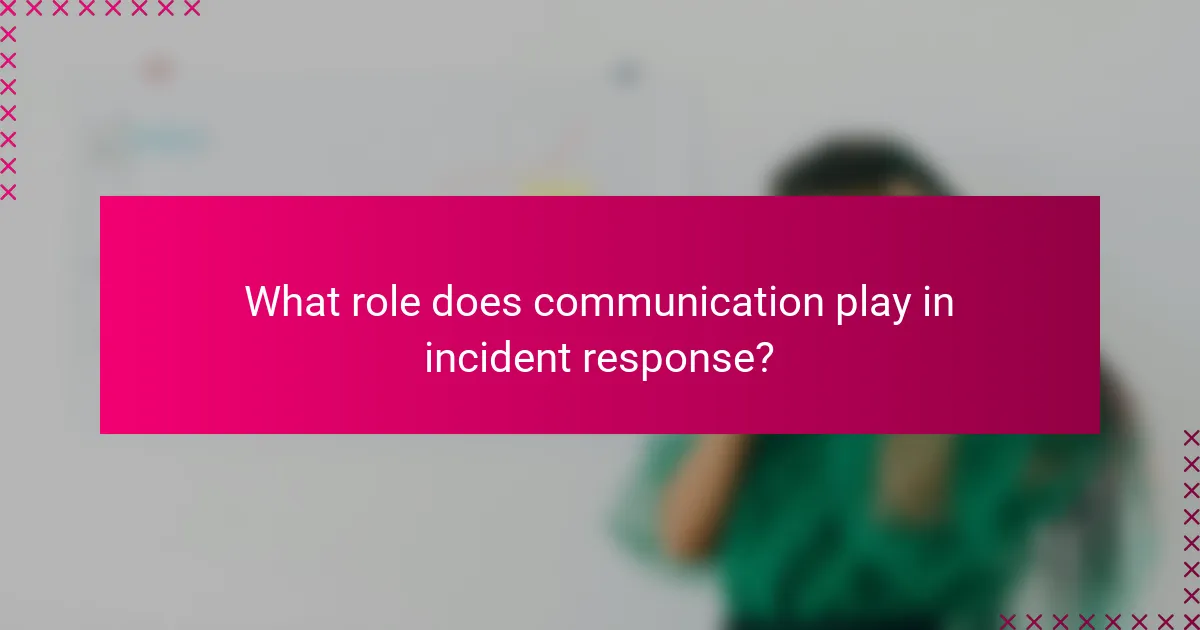
What role does communication play in incident response?
Communication is critical in incident response as it ensures that all stakeholders are informed, coordinated, and able to act effectively during a crisis. Clear communication minimizes confusion, facilitates timely decision-making, and helps maintain trust among employees, clients, and the public.
Internal communication protocols
Establishing robust internal communication protocols is essential for effective incident response. These protocols should outline who communicates what information, to whom, and when. Regular training and simulations can help ensure that all team members understand their roles and responsibilities during an incident.
Utilize tools like instant messaging platforms or dedicated incident response software to facilitate real-time updates. This can help teams share critical information quickly, reducing response times and improving overall coordination.
External stakeholder notifications
External notifications are vital for keeping stakeholders informed during an incident. This includes notifying clients, partners, and regulatory bodies about the situation and any potential impact on them. A well-defined notification process should specify the timing and content of these communications.
Consider creating templates for different types of incidents to streamline the notification process. Ensure that contact information for all key stakeholders is up to date to avoid delays in communication.
Media management strategies
Managing media communications effectively is crucial during an incident to control the narrative and protect the organization’s reputation. Designate a spokesperson who is trained to handle media inquiries and provide accurate information. This helps prevent misinformation and speculation.
Prepare key messages in advance that address potential questions and concerns. Regular updates should be provided to the media as the situation evolves, ensuring transparency while protecting sensitive information.
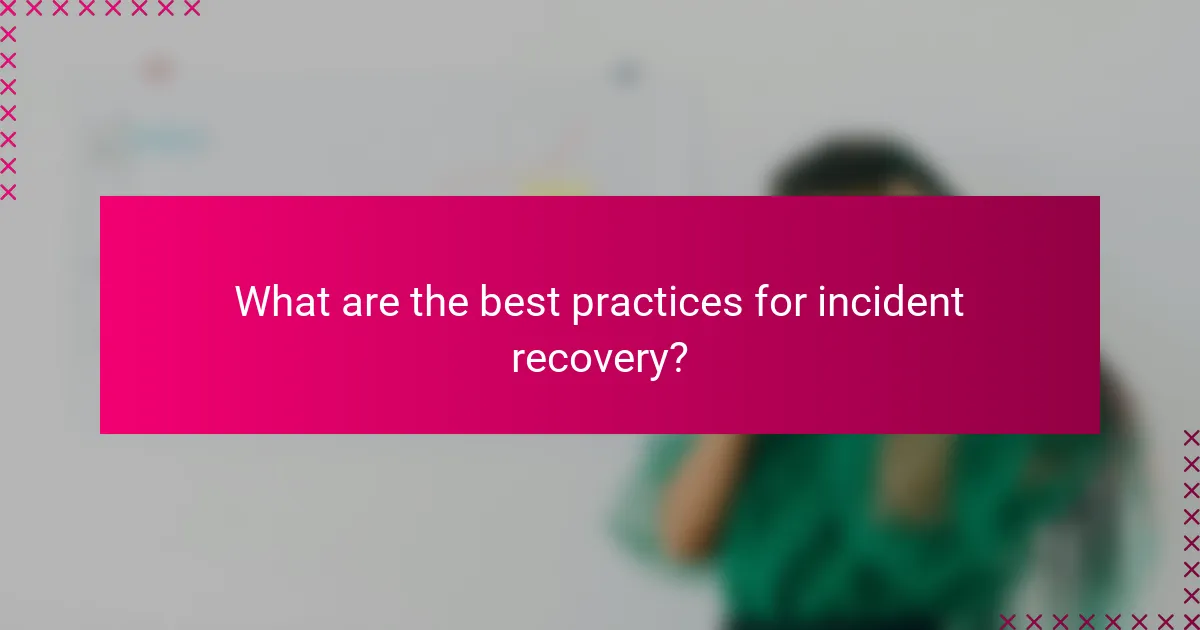
What are the best practices for incident recovery?
The best practices for incident recovery focus on minimizing downtime and ensuring data integrity. Key strategies include effective data backup, thorough system integrity checks, and ongoing improvement of recovery processes.
Data backup and restoration
Regular data backups are crucial for effective incident recovery. Establish a routine schedule for backups, ideally daily or weekly, depending on the volume of data changes. Utilize both on-site and off-site storage solutions to safeguard against data loss from physical disasters.
When restoring data, prioritize critical systems and applications to reduce downtime. Test restoration procedures periodically to ensure they function correctly and meet recovery time objectives (RTO).
System integrity checks
System integrity checks help verify that all components of your IT infrastructure are functioning correctly after an incident. Implement automated tools that can regularly scan for vulnerabilities and inconsistencies in system configurations.
After an incident, conduct a thorough review of logs and system performance to identify any anomalies. This can help prevent future incidents and ensure that your systems are secure and reliable.
Continuous improvement strategies
Continuous improvement strategies involve regularly assessing and updating your incident recovery plan. After each incident, conduct a post-mortem analysis to identify what worked, what didn’t, and how processes can be enhanced.
Engage your team in training exercises to simulate incidents and refine response strategies. This proactive approach not only strengthens your recovery capabilities but also fosters a culture of preparedness within your organization.
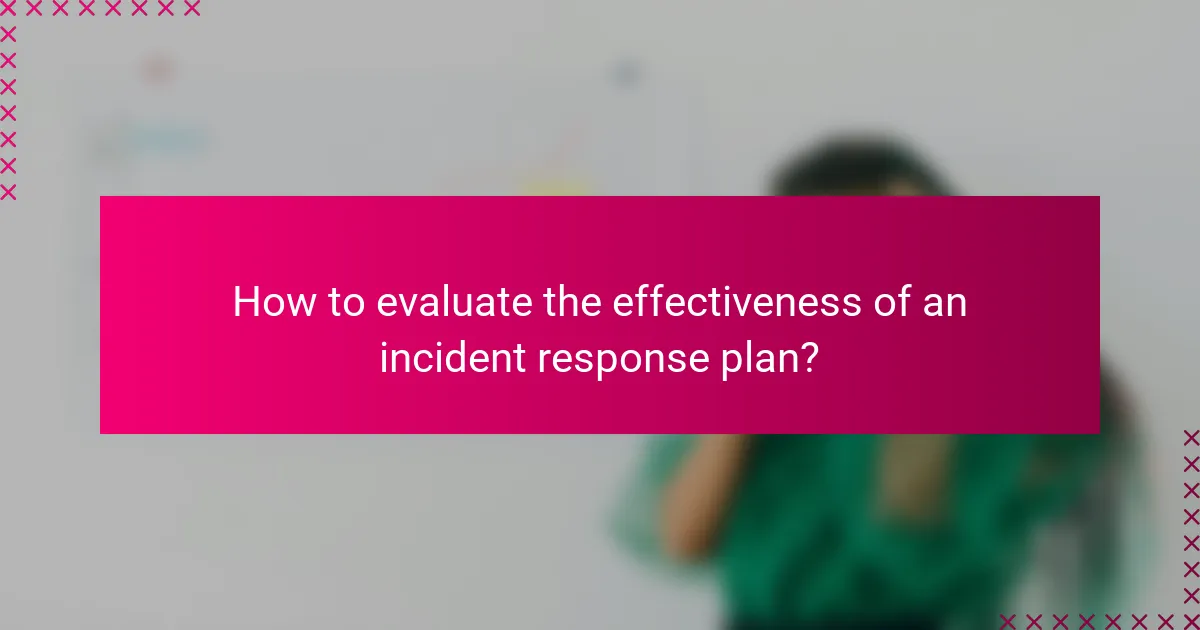
How to evaluate the effectiveness of an incident response plan?
To evaluate the effectiveness of an incident response plan, organizations should assess how well the plan meets its objectives during an incident. This involves analyzing response times, recovery outcomes, and communication efficiency to identify strengths and areas for improvement.
Metrics and KPIs
Key performance indicators (KPIs) and metrics are essential for measuring the effectiveness of an incident response plan. Common metrics include the time taken to detect an incident, the time to respond, and the time to recover. Establishing benchmarks for these metrics helps organizations track performance over time.
For example, organizations might aim for incident detection within minutes and recovery within hours. Regularly reviewing these metrics allows teams to identify trends and adjust their response strategies accordingly.
Post-incident analysis
Post-incident analysis is crucial for understanding the effectiveness of an incident response plan. After an incident, teams should conduct a thorough review to evaluate what worked well and what did not. This analysis should include feedback from all stakeholders involved in the response process.
During the review, consider documenting lessons learned and updating the incident response plan based on findings. This iterative process helps improve future responses and ensures that the organization is better prepared for similar incidents. Common pitfalls to avoid include neglecting to involve all relevant parties and failing to act on identified improvements.

What tools can enhance incident response in SaaS environments?
Several tools can significantly improve incident response in Software as a Service (SaaS) environments. These tools facilitate monitoring, communication, and recovery processes, ensuring that organizations can respond effectively to incidents and minimize downtime.
Monitoring and Detection Tools
Monitoring and detection tools are essential for identifying potential incidents before they escalate. Solutions like intrusion detection systems (IDS) and security information and event management (SIEM) platforms continuously analyze network traffic and logs to detect anomalies. For example, tools such as Splunk or Datadog can provide real-time insights into system performance and security threats.
When selecting monitoring tools, consider factors such as integration capabilities with existing systems, ease of use, and scalability. A good practice is to set up alerts for critical incidents, allowing teams to respond promptly and effectively.
Communication Platforms
Effective communication is vital during an incident response. Platforms like Slack or Microsoft Teams can streamline communication among team members, ensuring everyone is informed and coordinated. Establishing dedicated channels for incident response can help manage discussions and updates efficiently.
Additionally, using incident management tools like PagerDuty or Opsgenie can automate notifications and escalate issues to the right personnel. This ensures that the appropriate team members are alerted based on the severity of the incident, reducing response times.
Recovery and Backup Solutions
Recovery and backup solutions are crucial for restoring services after an incident. Tools like Veeam or Acronis provide backup and disaster recovery capabilities, allowing organizations to quickly restore data and applications. Regularly testing these recovery processes is essential to ensure they work effectively when needed.
It’s advisable to implement a 3-2-1 backup strategy: keep three copies of your data, on two different media types, with one copy stored offsite. This approach enhances data resilience and ensures that organizations can recover from various types of incidents.
